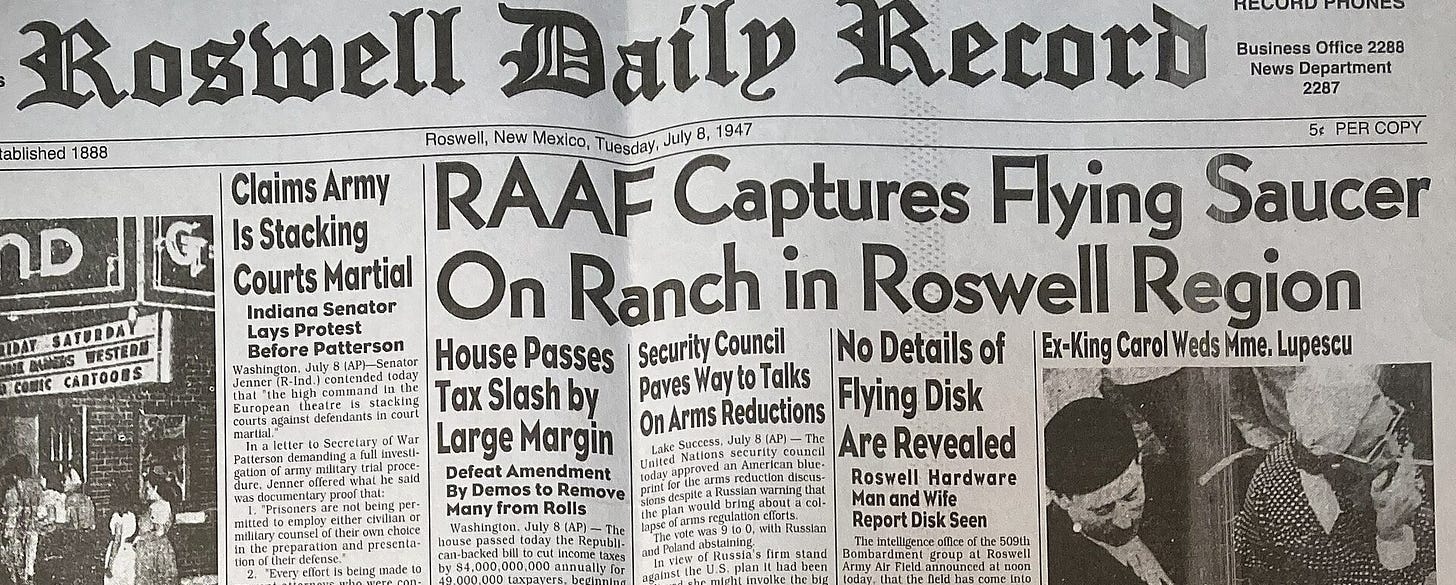First off, Part II of my opus on the Museum of Science and Industry and how it got that way has published in the Hyde Park Herald. This chapter is about the Field Columbian Museum, its fight to get into Grant Park, and the fight to save the building. Here is the opening of the Field Columbian Museum in 1894.
Part I was about the creation of the Palace of Fine Arts for the 1893 World’s Columbian Exposition (after the building that now houses the Art Institute proved inadequate). August St. Gaudens said it was the most beautiful building since the Parthenon.
Roswell
I was amused while researching the Museum of Science and Industry to come across a letter to the editor in the 1988 Tribune from Jack Star, laughing about his news reporting failure and his intersection with the Roswell UFO legend.
He was the night city editor of an unnamed Chicago newspaper in 1947. One of the workers on a slow night decided to decode requests that were sent over the United Press bureau telegraph. The requests were coded because they were requests for assistance in writing a news article that wasn’t yet public. The assistant brought the message to Jack Star. It came from Albuquerque, New Mexico. They said that a flying saucer had crashed near Roswell. The paper had learned that the bodies of four small men had been taken from the saucer and had been sent to University of Chicago secret laboratories in the Museum of Science of Industry. The alien autopsy!
Everyone in Chicago knew that the university had something secret going on there. There were rumors of flickering lights—were they energy drains from experiments? Jack Star decided to investigate. He called people at the museum and university. Everyone refused to comment. He contacted a guy in New Mexico who was “researching” the UFO. He confirmed the crash and offered to send x-rays of the four little men. Jack Star thought that he had a scoop and ran with the story complete with the x-ray evidence. And then he went home.
When he came in the next day, no one would look at him. The x-rays were of human fetuses and his scoop was an utter embarrassment that they’d managed to kill. Star laughed in 1988 that the incident meant he never did get a promotion at the newspaper, which was, in fact, the Sun-Times. While there, he got to be the one to call Gwendolyn Brooks and tell her that she’d won the Pulitzer Prize. His embarrassing brush with conspiracies didn’t stop his career.
Apparently, there was no reluctance to print a story at the Roswell Daily Record, which reported that the Roswell Army Air Field had the flying saucer.

According to Wikipedia, the facts are that a rancher named Brazel had found tinfoil, rubber, tape, and thin wooden beams scattered across several acres of his ranch.
He hadn’t thought much about it until his uncle thought it might be one of these UFOs he’d heard about, so they turned the debris into the Army Air Force at Roswell, which didn’t know what they were looking at. They announced they had a flying disc, and the news ran with it. The next day the Army said it was a radar target weather balloon. There were grumbles about a cover up but the news was forgotten until the 1970s when a retired officer said he could tell that the Army was covering something up and maybe it had been extraterrestrial. And from that, an industry was born.
Then, in the 1990s, according to Wikipedia, the United States Air Force published multiple reports showing that the debris was from Project Mogul, which was top secret at the time, so it was a cover up but not of aliens. Project Mogul was an effort to find out whether the Soviets were doing atomic bomb tests. They were sending up high altitude balloons with long-distance sound wave detectors from the Alamogordo Army Air Field, 150 miles away from Roswell. They stopped sending up balloons when they realized they could use seismic waves instead of sound. So it figures that an officer at Roswell wouldn’t know about the top-secret project at Alamogordo but could sense a cover up. People love a conspiracy theory as we know now all too well.
Back to Jack Star—It seemed in his telling to be just a funny paranoid rumor complete with flickering lights. But as I read about Project Mogul, I realized I’d wandered down a more interesting rabbit hole than I’d thought. The newspaper in Albuquerque had probably picked up a real lead. I knew that the University of Chicago had taken over 17,000 feet of floor space in the east wing of the Museum of Science and Industry for researching ultra-high frequency radio and for training signal corps officers in its use. When Jack Star called museum officials and people at the university of course they stone walled. Top-secret debris probably had arrived from New Mexico. There just weren’t little grey men among the tinfoil and receptors testing for atomic blasts.
My favorite year on the Halloween street (Harper Avenue aka the Rosalie Villas, which you can read about here and here) was the year the neighbors collaborated on the Alien Autopsy. They had an alien lying under a sheet on a gurney attended by doctor mannequins in the little remnant of park by 59th and the Metra Station. Then many yards had crashed spaceships, references to Roswell, and little green men in various costumes. If only they’d known that the alien autopsy was once (supposedly) taking place just three blocks away.










Fascinating stuff!